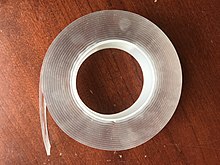Synthetic setae
The sheer abundance and proximity to the surface of these spatulae make it sufficient for van der Waals forces alone to provide the required adhesive strength.
These developments are poised to yield families of novel adhesive materials with superior properties which are likely to find uses in industries ranging from defense and nanotechnology to healthcare and sport.
The mechanism of microinterlocking which suggested that the curved tips of setae could act as microscale hooks was also challenged by the fact that geckos generate large adhesive forces even on molecularly smooth surfaces.
The possibilities finally narrowed down to intermolecular forces, and the development of electron microscopy in the 1950s, which revealed the micro-structure of the setae on the gecko's foot, provided further proof to support this hypothesis.
The problem was finally solved in 2000 by a research team led by biologists Kellar Autumn of Lewis & Clark College in Portland, Oregon, and Robert Full at the University of California at Berkeley.
The combined effect of millions of spatulae provides an adhesive force many times greater than the gecko needs to hang from a ceiling by one foot.
Their discovery revealed that gecko adhesive actually works in a 'programmable' way that by increasing the angle between the setal shaft and the substrate to 30 degrees, no matter how big the perpendicular adhesive force is, geckos 'turn off' the stickiness since the increased stress at the trailing edge of the seta causes the bonds between seta and the substrate to break.
In other words, the Van der Waals interaction energy for the particle-wall system requires a sufficiently great number of particle-spatula systems to counterbalance; however, relatively few spatulae can actually attach to a single particle, therefore the contaminant particles tend to attach to the substrate surface rather than the gecko's toe due to this disequilibrium.
The discoveries about gecko's feet led to the idea that these structures and mechanisms might be exploited in a new family of adhesives, and research groups from around the world are now investigating this concept.
And thanks to the development of nano science and technology, people are now able to create biomimetic adhesive inspired by gecko's setae using nanostructures.
Effective design of geckolike adhesives will require deep understanding of the principles underlying the properties observed in the natural system.
In the first developments of synthetic setae, polymers like polyimide, polypropylene and polydimethylsiloxane (PDMS) are frequently used since they are flexible and easily fabricated.
CNTs have much larger possible length-to-diameter ratio than polymers, and they exhibit both extraordinary strength and flexibility, as well as good electrical properties.
This example is one of the first developments of synthetic setae, which arose from a collaboration between the Manchester Centre for Mesoscience and Nanotechnology, and the Institute for Microelectronics Technology in Russia.
[13] The group prepared flexible fibers of polyimide as the synthetic setae structures on the surface of a 5 μm thick film of the same material using electron beam lithography and dry etching in an oxygen plasma.
Later experiments[16] with the same structures on Scotch tape revealed that this material could support a shear stress of 36 N/cm2, nearly four times higher than a gecko foot.
[17] The resulting adhesive, named 'geckel', was described to be an array of gecko-mimetic, 400 nm wide silicone pillars, fabricated by electron-beam lithography and coated with a mussel-mimetic polymer, a synthetic form of the amino acid that occurs naturally in mussels (left).
Unlike true gecko glue, the material depends on van der Waals forces for its adhesive properties and on the chemical interaction of the surface with the hydroxyl groups in the mussel protein.
a range of different techniques which include deep reactive ion etching (DRIE), which has been used successfully to fabricate mushroom-shaped polymer fibre arrays, micro-moulding processes, direct self-assembly and photolithography.
[citation needed] In 2006, researchers at BAE Systems Advanced Technology Centre at Bristol, UK, announced that they had produced samples of "synthetic gecko" – arrays of mushroom-shaped hairs of polyimide – by photolithography, with diameters up to 100 μm.
[citation needed] More recently, the company has used the same technique to create patterned silicon moulds to produce the material and has replaced the polyimide with polydimethylsiloxane (PDMS).
Photo-lithography has the benefit of being widely used, well understood and scalable up to very large areas cheaply and easily, which is not the case with some of the other methods used to fabricate prototype materials.
[22] Rather than relying on photolithography or other micro-fabrication strategies, the researchers employed electrospinning to produce small diameter fibers based on the principle of contact splitting exploited by geckos.
The product has reported shear strength greater than 80 pounds per square inch, with clean removal and reusability on many surfaces, and the ability to laminate the material to various face stocks in one or two sided constructions.
[24] No machine yet exists that can maneuver in the "scansorial" regime – that is, perform nimbly in general vertical terrain environments without loss of competence in level ground operation.
Two major research challenges face the development of scansorial robotics: First, they seek to understand, characterize and implement the dynamics of climbing (wall reaction forces, limb trajectories, surface interactions, etc.
These crawler and climbing robots can be used in the military context to examine the surfaces of aircraft for defects and are starting to replace manual inspection methods.
Researchers at Stanford University have also created a robot called Stickybot which uses synthetic setae in order to scale even extremely smooth vertical surfaces just as a gecko would.
Adhesives based on synthetic setae have been proposed as a means of picking up, moving and aligning delicate parts such as ultra-miniature circuits, nano-fibres and nanoparticles, microsensors and micro-motors.
In the macro-scale environment, they could be applied directly to the surface of a product and replace joints based on screws, rivets, conventional glues and interlocking tabs in manufactured goods.









